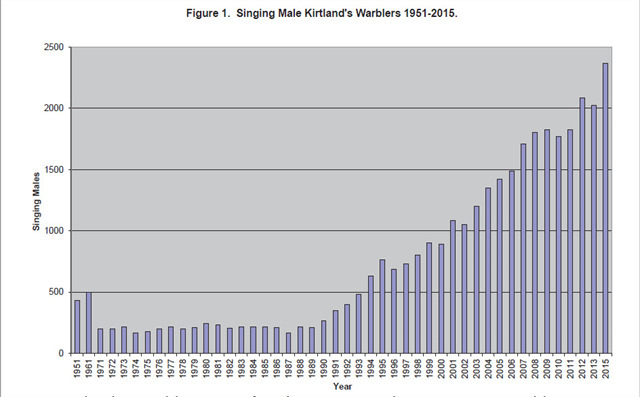Welcome to the Kirtland's Warbler GeoTrail (KWGT). This trail will take you in a loop in central Northern Michigan through the Jack Pine ecosystem, breeding home of the Kirtland's Warbler. This tour takes you to a total of 25 caches with an amazing trackable geocoin as a reward. The KWGT Passport can be downloaded here: https://f81c572e-1d95-4026-befc-8c60f69cbcd9.filesusr.com/ugd/31e003_41b2f3aa918442e8b08c880e746e6946.pdf
Harold Mayfield organized the first Kirtland’s warbler census in 1951. The second census took place in 1961, and the third in 1971. After the census totals dropped 60 percent from 502 in 1961 to 201 in 1971, it was recommended to hold the census annually, starting in 1972, to closely monitor the population. The census was held annually from 1971 to 2013, with 2015 being the last full census conducted. The next full census is scheduled to be held in 2021. The results are also used as an aid for evaluating management and forestry practices.
The Kirtland’s Warbler census is conducted June 6-20, and is a count of singing males, as the females do not sing. It is generally assumed that there is one female for each male. Although this is not always true, one can double the singing male count to get an approximation of the number of adults. The male is a loud and persistent singer, and in good listening conditions, can be heard a over a quarter of a mile away. Some people describe the Kirtland’s song as “tup tup chee chee wee wee”, but personally I don’t hear it that way. One biologist said the birds in the UP sing “tup tup chee chee wee wee, eh”. Censuses start about 7 am and end by 11 am The census is done with as little disturbance to the birds as possible.
Kirtland’s only need be heard, not seen, to be counted. In large areas, census personnel simultaneously walk parallel transects about 0.2 miles apart. Roads, trails and habitat edges are used whenever possible to lessen disturbance of the warblers. State or federal permits are required to enter all Kirtland’s warbler breeding areas. When a male is heard, its location is marked on a map. Smaller areas can be checked from the habitat edge. Afterwards, the maps are compared with those of the adjacent transect to avoid over counting.
In 2015, there were 2,344 singing males counted in Michigan, of which 2,307 were located in the Lower Peninsula and 37 in the Upper Peninsula. Wisconsin reported 19 males, and Ontario reported three, for a North American total of 2,366. This is the highest total ever recorded.
The warbler population has been on an upward climb since a low of 167 males in 1987. The 2,344 Michigan males counted in 2015 are 14 times more than in 1987.

Graph from Petrucha, M. E., K. Kintigh, and P. Huber. 2016. The 2015 Kirtland's Warbler Census. Michigan Birds and Natural History 23:1-6.
The Kirtland's Warbler census is a cooperative effort of the Michigan Department of Natural Resources, U. S. Forest Service, U. S. Fish and Wildlife Service, Michigan Department of Military Affair, and many volunteers.
Cache
The cache is located at the traditional meeting spot where 50 or so census personnel would meet at about 6:00 am to get their census maps and instructions before heading out to their assigned areas. It is interesting to note (at least to me) that census numbers remained fairly steady from 1971 to 1989, with numbers starting an upward trend in 1990. 1990 also happens to be the year I became involved in Kirtland's Warbler recovery efforts (just sayin').